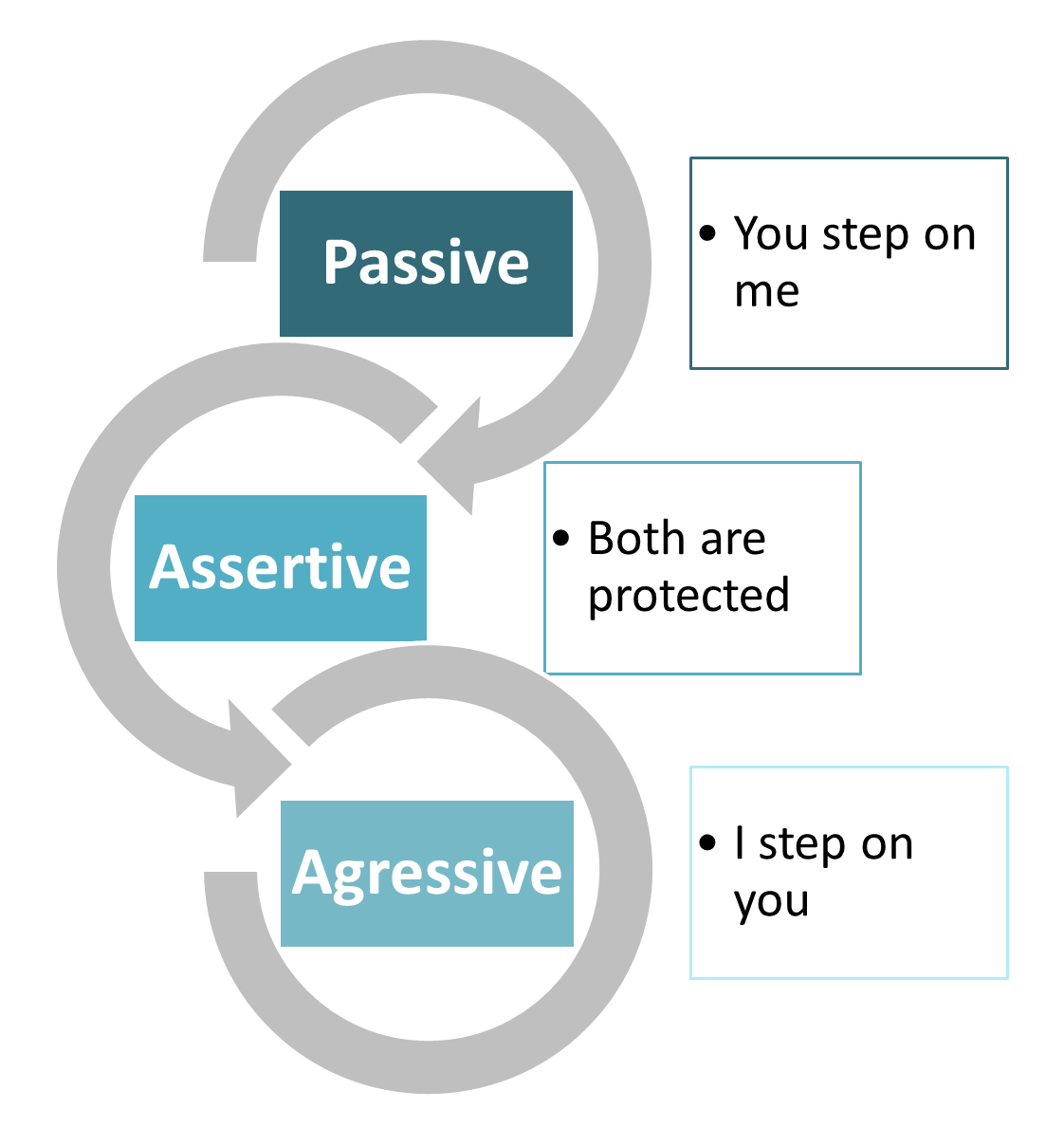8.3 Asserting Your Needs
In this section:
The Passive-Assertive-Aggressive Continuum

People tend to relate to communicate their needs using one of three strategies:
- Passive communicators tend to put the rights of others before their own. Passive communicators tend to be apologetic or sound tentative when they speak. They do not speak up if they feel like they are being wronged.
- Assertive communicators respect their rights and the rights of others when communicating. This person tends to be direct but not insulting or offensive. The assertive communicator stands up for his or her own rights but makes sure the rights of others aren’t affected.
- Aggressive communicators, on the other hand, will come across as standing up for their rights while possibly violating the rights of others. This person tends to communicate in a way that tells others they don’t matter or their feelings don’t matter.
Table 8.9 Passive, Assertive, Aggressive Communication Examples.
| Passive | Assertive | Aggressive | |
|---|---|---|---|
| Definition | Communication style in which you put the rights of others before your own, minimizing your own self-worth | Communication style in which you stand up for your rights while maintaining respect for the rights of others | Communication style in which you stand up for your rights but you violate the rights of others |
| Implications to others | My feelings are not important | We are both important | Your feelings are not important |
| I dont matter | We both matter | You dont matter | |
| I think Im inferior | I think we are equal | I think Im superior | |
| Verbal styles | Apologetic | I statements | You statements |
| Overly soft or tentative voice | Firm voice | Loud voice | |
| Nonverbal styles | Looking down or away | Looking direct | Staring, narrow eyes |
| Stooped posture, excessive head nodding | Relaxed posture, smooth and relaxed movements | Tense, clenched fists, rigid posture, pointing fingers | |
| Potential consequences | Lowered self-esteem | High self-esteem | Anger from others |
| Anger at self | Self-respect | Lowered self-esteem | |
| False feelings of inferiority | Respect from others | Disrespect from others | |
| Disrespect from others | Respect of others | Feared by others | |
| Pitied by others | |||
| Source: Making Conflict Suck Less: The Basics by Ashley Orme Nichols, CC BY-NC-SA 4.0. | |||
Most of us tend to have a consistent way we relate to communication, and therefore conflict. The majority of people are either mostly passive (avoidant and accommodating) or mostly aggressive (competitive) with much fewer people regularly being assertive (collaborative). That being said, regardless of where you typically land on the passive – assertive – aggressive continuum, most of us have work to do when it comes to being more assertive in our lives.
Being Assertive – I Statements
One word that is often used for being assertive in our society today is to draw or hold our “boundaries”. In a physical space, boundaries are easy to identify, such as a fence, stop signs, or a door. Boundaries in our social experiences are not as easy to identify but are just as real and important as physical boundaries. Fences and doors tell us where it is safe to go, and how to behave. The same is true when we are assert our social boundaries, think of them as the invisible fences or doors we draw in our lives. Asserting our social boundaries, tell those around us what is acceptable and what isn’t acceptable in our interaction, they are the guidelines and rules we provide people around us for how we want our relationship with them to look.
I-statements allow you to directly express your thoughts, needs, feelings, and experiences to the people around you. I-statements allow us to take responsibilities for our experiences and places the power of our lives in our hands. I-statements look like this:
- I feel…
- I think…
- I experienced it like this…
- I want…
- I need…
I-statements are contrasted with You-statements. Statements that imply the other person is responsible for something. You-statements typically blame on the other person. You statements look like this:
- You made me feel…
- You don’t care about me.
- You never think about how that would impact us.
- You didn’t…
Table 8.10 - I Statements vs You-Statements
| I-Statements vs You-Statements | |
|---|---|
| I felt unappreciated. | You don't care about me. |
| I need some help. | You are a freeloader and never help. |
| I felt... | You made me feel.... |
| It makes me sad to be left out. | You never invite me out with your friends. |
| Source: Making Conflict Suck Less: The Basics by Ashley Orme Nichols, CC BY-NC-SA 4.0. | |
Watch out for those fake I-Statements that so regularly sneak into our conversations. “I feel you…”, “I think you”, “I want you to…” are hidden You-Statements.
Creating an I Statement
Robert Bolton (1979), he gives us a simple but effective template for developing assertive messages to help us draw boundaries:
- When you_________ (a nonjudgmental description of someone’s behavior)
- I feel_____ (a specific feeling)
- Because____ (how someone’s behavior directly impacts you, how they have crossed a boundary)
Different Ways to Assert Yourself
There are many types of assertions, the template above is just a start. The examples below are hardly exhaustive, it is just to give you a sense of the different ways to be assertive and hold your boundaries. Sometimes even when you assert yourself and hold your boundaries, the people in your life might not respect them. Robert Bolton (1979) shares with us that part of being assertive and holding boundaries might be:
- Selective Inattention – ignoring unwanted behavior if it is a one time occurrence
- Temporary Withdrawal – taking time away from a relationship that doesn’t respect your boundaries
- Permanent Withdrawal – ending a relationship because your boundaries aren’t respected
Think about this as an order of progression. You assert your boundaries, if they aren’t respected you can ignore the other person’s behavior and assert yourself again. If this person continues to step on and not respect your boundaries you might need to take some time apart. If that behavior continues, you might need to end that relation. This can happen with friends, partners, co-workers, and even family.
A basic act of being assertive is simply saying “no”. Saying no without little white lies or justifying why you are saying no takes some practice. Have you ever been invited out with friends but didn’t want to go? Did you make something up? “I’m busy” when really you just don’t want to go out. Being assertive in that moment looks like “I really appreciate the offer, and I hope you invite me in the future, but no, I just need some me time”.
When Not to Assert
There is a wonderful acronym to remember when you are considering being assertive. HALT. Ask yourself, are you?
- Hungry?
- Angry?
- Lonely?
- Tired?
If you answer yes to any of those questions, then HALT. Satisfy your needs, whether that is eating a snack, taking a deep breath, connecting with someone, or taking a nap. Then reevaluate your need to assert a boundary. If the need is still there, then proceed with delivering your assertive message.
When asserting a boundary, it is important to carefully choose your channel of communication. This article from Psychology Today talks about Things to not send in a text. Assertive messages are important and often ideally in a synchronous, information rich transaction, ideally a face-to-face conversation.
The Assertion Process
Imagine you know it’s time to draw a boundary with someone close to you, you’ve thought long and hard about what is important to you, you know what you want to say, So what do you do now? Robert Bolton (1979), gives us a process to follow when delivering our assertion:
- Preparation
- Delivering the Message
- Silence
- Active Listening
- Recycle steps 2-4 (as necessary)
- Focus on a Solution
Preparation – In the preparation stage you spend time, before you enter into a conversation with the other person, reflecting on what is important for you to convey, developing your framing (see below) and assertion message, and preparing yourself for this process and active listening.
Deliver the Message – Share your frame and your assertion message
Silence – Allow the other person time to process what you have just said. Sometimes after we assert ourselves, we want to justify ourselves, or jump in when there is silence because it can be awkward and uncomfortable. Take a deep breath while they consider what you have just said, they may have not considered this topic before this very moment.
Active Listening – Once the person responds to your assertion, your job is to reflect back what their response is. This response could be defensive, it could be off track from your original topic, or they could shut down. Actively listening to the other person will likely be the last thing you want to do, so make sure to prepare for this part of the process as much as you can in the preparation step.
Recycle Steps 2-4 (as necessary) – You will likely have to reassert yourself, provide more silence, and actively listen a few times, before you can move into the next step in the process. This part of the process allow you and the other person to really understand each other and get on the same page.
Focus on A Solution – Often times in conflict we jump to this step without taking the time to go through steps 1-5. Only focus on a solution after you have understood the other person, they have understood you, and you are both ready and capable of focusing on a solution.
Let’s Focus: Asserting Your Boundaries
 While this assertion template seems really simple, it actually can be quite challenging to utilize. Some tips for making sure that you are asserting your boundaries in a productive way.
While this assertion template seems really simple, it actually can be quite challenging to utilize. Some tips for making sure that you are asserting your boundaries in a productive way.
- Focus on one behavior at a time. If you have been more passive in your communications you might want to jump into drawing all the boundaries. Pick one to start with and work from there
- Describe the behavior you chose to focus on in a nonjudgmental way (easier than it sounds) with nonjudgmental language. Example – “When you don’t pick up your crap” vs “When you leave dirty laundry in the bathroom”
- Pick a very specific feeling (most specifics on this below)
- Watch out for a feeling statement that says “I feel you…” the feeling word should describe your feeling in this situation, not be about the other person Example- “I feel like you don’t care” vs “I feel hurt”
- When you describe the impact on you, really express how someone’s behavior impacts you. Think back to the types of goals or SCARF model trigger, express what is really going on for you
- Keep it concise.
- Use this template for positive reinforcement of behavior you want to keep seeing. When you pick up your dirty clothes, I feel appreciative, because I don’t have to take time to pick them up.
Framing and Reframing
Framing, in communication, is essentially the act of intentionally setting the stage for the conversation you want to have. In framing a conversation you express why you want to engage in this topic, what your intent is, and what you hope the outcome can be for resolving the conflict, as well as the impact/importance of your relationship. When you frame a conversation, you take out the need for the other person to assume what your intentions and motives are or why you are bringing this topic up right now.
There are many ways to frame a conversations, here are a few ideas for how to frame a conversation effectively.
Ask if this is a good time to talk.
“I have been wanting to connect with you to discuss___. Would now be a good time?” (If the answer is no, take a minute to schedule a good time)
Consider Sharing Your “Why” , Concerns and Intentions
“This is important to me because…..”
“I’m only bringing this up because I want us and this project to be successful and I’m worried that we are missing something.”
“My intention is….”
“My intention is to share my thoughts with you, but I don’t have any expectations that you do anything with them.”
“I care about our relationships and want to make sure we are addressing challenges as they come up.” “I’m not sure how this will go.”
“I’m pretty stressed about this because I’m not sure how this conversation is going to go.”
“I have been thinking about this a lot and figured it was time to ask for help.”
Framing a Boundary
Framing sets the stage for the rest of the conversation to unfold. A little bit of framing goes a long way in helping conversations be more productive, and help manage some of the conflict that can happen when people have to make assumptions about “why” and conversation or conflict is happening.
“I know this is important to you and I’m just too busy to go to that concert right now. “
“I can see this isn’t a good time to talk, so I’d like to set up a time that works better.”
“I’m sorry, I already have too much on my plate.”
“I appreciate you thinking of me for this project. I’m currently working on X, which means unfortunately, I can’t do both and have to say no to your request.”
 For more ideas around framing, The Gottman institute has a really great infographic that shares their version of framing: Harsh Start Ups vs Soft Start Ups.
For more ideas around framing, The Gottman institute has a really great infographic that shares their version of framing: Harsh Start Ups vs Soft Start Ups.Reframing
Framing happens at the beginning of a conversation, Reframing happens when things get off track and you need to bring a conversation back on topic. Consider this picture:

In the center of the picture is a frame, that is only covering part of the ocean and cliff. If we expanded that frame to surround the entire picture, that would be reframing. Reframing, in a conversation, helps us see more of what is going on, helps us focus on the larger picture or our end goals, and helps defuse tense situations. Reframing can be used for many things when managing conflict.
- Defusing inflammatory language
- Recasting negatives into neutral or positive statements
- Refocusing attention
- Acknowledging strong emotions in a productive manner
- Translating communication so that it is more likely to be heard and acknowledged by other parties
- Recontextualizing the dispute, providing a broader perspective
Table 8.11 Reframing Examples
| Original Statement | Reframed Statement |
|---|---|
| "You misinterpret everything." | "We must be misunderstanding each other. Can you help me understand what you meant" |
| "I am fed up with your negative response to everything that is proposed." | "I agree. Let's focus on finding a solution and move away from negativity." |
| "Can we just keep talking about this one detail?" | "If you are okay with it, can we make sure we have the big picture figured out before focusing on details? Maybe the details will become more clear then." |
| "That seems really petty! Can you believe that keeps happening?" | "That sounds irritating. What do you need to move past this moment and look for a solution." |
| Source: Making Conflict Suck Less: The Basics by Ashley Orme Nichols, CC BY-NC-SA 4.0. | |
Adapted Works
“Framing and Reframing” in Making Conflict Suck Less: The Basics by Ashley Orme Nichols is licensed under a Creative Commons Attribution-NonCommercial-ShareAlike 4.0 International License, except where otherwise noted.
“Conflict in Relationships” in Interpersonal Communication by Jason S. Wrench; Narissra M. Punyanunt-Carter; and Katherine S. Thweatt is licensed under a Creative Commons Attribution-NonCommercial-ShareAlike 4.0 International License, except where otherwise noted.
Non-Violent Conflict Management: Conflict Resolution, Dealing with Anger, and Negotiation, and Mediation by Susan Rice, University of California at Berkeley, California Social Work Education Center is licensed under a Creative Commons Non-commercial Attribution 4.0 Licence, except where otherwise noted.

